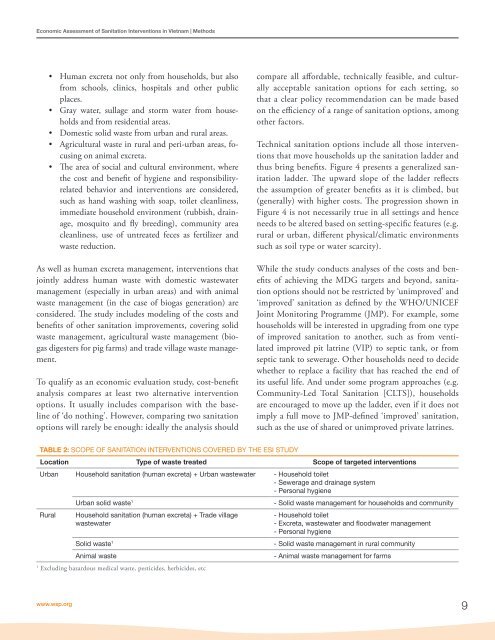Economic Assessment of Sanitation Interventions in Vietnam - WSP
Economic Assessment of Sanitation Interventions in Vietnam - WSP
Economic Assessment of Sanitation Interventions in Vietnam - WSP
You also want an ePaper? Increase the reach of your titles
YUMPU automatically turns print PDFs into web optimized ePapers that Google loves.
<strong>Economic</strong> <strong>Assessment</strong> <strong>of</strong> <strong>Sanitation</strong> <strong>Interventions</strong> <strong>in</strong> <strong>Vietnam</strong> | Methods• Human excreta not only from households, but als<strong>of</strong>rom schools, cl<strong>in</strong>ics, hospitals and other publicplaces.• Gray water, sullage and storm water from householdsand from residential areas.• Domestic solid waste from urban and rural areas.• Agricultural waste <strong>in</strong> rural and peri-urban areas, focus<strong>in</strong>gon animal excreta.• The area <strong>of</strong> social and cultural environment, wherethe cost and benefit <strong>of</strong> hygiene and responsibilityrelatedbehavior and <strong>in</strong>terventions are considered,such as hand wash<strong>in</strong>g with soap, toilet cleanl<strong>in</strong>ess,immediate household environment (rubbish, dra<strong>in</strong>age,mosquito and fly breed<strong>in</strong>g), community areacleanl<strong>in</strong>ess, use <strong>of</strong> untreated feces as fertilizer andwaste reduction.As well as human excreta management, <strong>in</strong>terventions thatjo<strong>in</strong>tly address human waste with domestic wastewatermanagement (especially <strong>in</strong> urban areas) and with animalwaste management (<strong>in</strong> the case <strong>of</strong> biogas generation) areconsidered. The study <strong>in</strong>cludes model<strong>in</strong>g <strong>of</strong> the costs andbenefits <strong>of</strong> other sanitation improvements, cover<strong>in</strong>g solidwaste management, agricultural waste management (biogasdigesters for pig farms) and trade village waste management.To qualify as an economic evaluation study, cost-benefitanalysis compares at least two alternative <strong>in</strong>terventionoptions. It usually <strong>in</strong>cludes comparison with the basel<strong>in</strong>e<strong>of</strong> ‘do noth<strong>in</strong>g’. However, compar<strong>in</strong>g two sanitationoptions will rarely be enough: ideally the analysis shouldcompare all affordable, technically feasible, and culturallyacceptable sanitation options for each sett<strong>in</strong>g, sothat a clear policy recommendation can be made basedon the efficiency <strong>of</strong> a range <strong>of</strong> sanitation options, amongother factors.Technical sanitation options <strong>in</strong>clude all those <strong>in</strong>terventionsthat move households up the sanitation ladder andthus br<strong>in</strong>g benefits. Figure 4 presents a generalized sanitationladder. The upward slope <strong>of</strong> the ladder reflectsthe assumption <strong>of</strong> greater benefits as it is climbed, but(generally) with higher costs. The progression shown <strong>in</strong>Figure 4 is not necessarily true <strong>in</strong> all sett<strong>in</strong>gs and henceneeds to be altered based on sett<strong>in</strong>g-specific features (e.g.rural or urban, different physical/climatic environmentssuch as soil type or water scarcity).While the study conducts analyses <strong>of</strong> the costs and benefits<strong>of</strong> achiev<strong>in</strong>g the MDG targets and beyond, sanitationoptions should not be restricted by ‘unimproved’ and‘improved’ sanitation as def<strong>in</strong>ed by the WHO/UNICEFJo<strong>in</strong>t Monitor<strong>in</strong>g Programme (JMP). For example, somehouseholds will be <strong>in</strong>terested <strong>in</strong> upgrad<strong>in</strong>g from one type<strong>of</strong> improved sanitation to another, such as from ventilatedimproved pit latr<strong>in</strong>e (VIP) to septic tank, or fromseptic tank to sewerage. Other households need to decidewhether to replace a facility that has reached the end <strong>of</strong>its useful life. And under some program approaches (e.g.Community-Led Total <strong>Sanitation</strong> [CLTS]), householdsare encouraged to move up the ladder, even if it does notimply a full move to JMP-def<strong>in</strong>ed ‘improved’ sanitation,such as the use <strong>of</strong> shared or unimproved private latr<strong>in</strong>es.TABLE 2: SCOPE OF SANITATION INTERVENTIONS COVERED BY THE ESI STUDYLocation Type <strong>of</strong> waste treated Scope <strong>of</strong> targeted <strong>in</strong>terventionsUrban Household sanitation (human excreta) + Urban wastewater - Household toilet- Sewerage and dra<strong>in</strong>age system- Personal hygieneRuralUrban solid waste 1Household sanitation (human excreta) + Trade villagewastewaterSolid waste 1Animal waste1Exclud<strong>in</strong>g hazardous medical waste, pesticides, herbicides, etc- Solid waste management for households and community- Household toilet- Excreta, wastewater and floodwater management- Personal hygiene- Solid waste management <strong>in</strong> rural community- Animal waste management for farmswww.wsp.org9
















